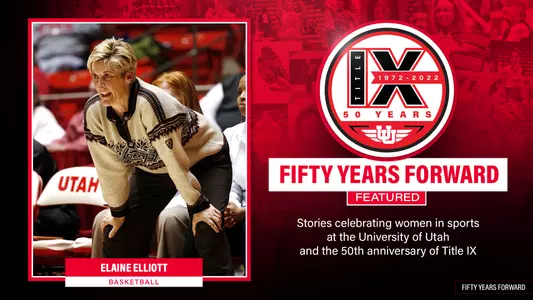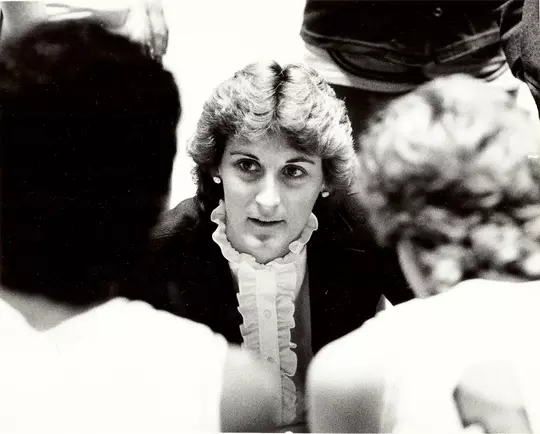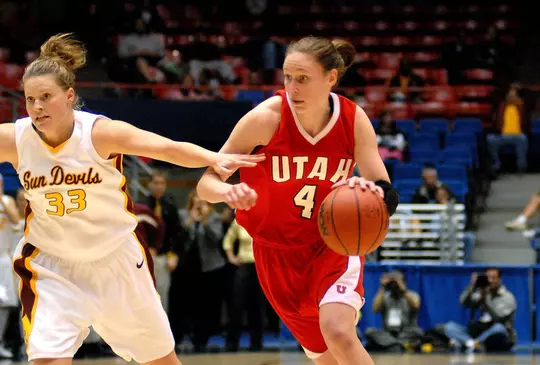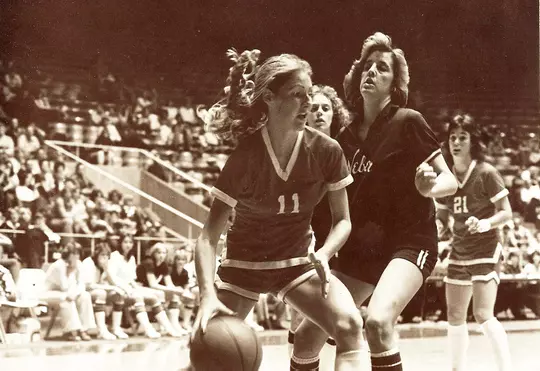Completed Event: General versus Arizona on January 18, 2002

General

7/26/2022 11:00 AM | General, Women's Basketball
Elaine Elliott, head coach of the Utah women’s basketball program for 27 years, experienced a wave of changes during her time around the game.
Fourth In A Series
By Dirk Facer
When it comes to basketball, long-time University of Utah women’s coach Elaine Elliott describes herself as “part of a generation that sort of went through everything.” She added that it was kind of crazy.
To see how women’s basketball has truly evolved, all you need to do is study Elliott’s time around the game. When she was in elementary school, there was 3-on-3. That became a bizarre 2-2-2 format by sixth and seventh grade. Then in eighth grade, Elliott and other females were finally able to play organized 5-on-5 basketball. The AAU and college officials adopted the rule change in 1971, the year before equality was enacted through Title IX.
Much of Title IX’s intent, however, dealt with the challenges of funding and other matters. It took time for progress to really get rolling. Elliott, who played for Boise State, said she didn't get any scholarship money until her senior year in 1976-77.
Funding also altered recruiting, transforming the college game into what we see it as today.
“It started, really, with regionalization changing to national opportunities. That’s kind of as simple as I could put it,” Elliott said. “Kids weren’t going to get recruited nationally. Girls didn’t have chances to think about going anywhere they wanted. Any opportunities were very regional in the beginning, and prior to that there were no opportunities.”

The Association for Intercollegiate Athletics for Women (AIAW), the governing body at the time, initially did not permit off-campus recruiting or the awarding of scholarships.
“They didn’t have the capacity to be any different, meaning they didn’t have money to choose any other path,” Elliott said. “We have to be kind of honest about that. That’s why it was regional and that’s why everything was obviously purely amateur.”
There were no debates about where women’s athletics fit in, she added, in terms of how much funding they received. The AIAW was very different philosophically than how things are now. So much so that the eventual NCAA takeover appeared to be a monetary move. Elliott recalls it being kind of sad.
“We didn't like the lack of resources but we liked the philosophy that women had the opportunity to compete under with the AIAW,” she said. “But we knew that under the structure of the NCAA women’s sports would ultimately follow the same path as the men’s sports took. We wouldn’t be able to do it differently.”
The one difference, however, has been the timeline of progress. Since the passage of Title IX 50 years ago, the growth of women’s programs has been slow at times — sometimes painfully slow. Elliott acknowledged that women were not happy about that.
“It was definitely a process,” she said, as funds weren’t readily available.
It started, really, with regionalization changing to national opportunities. Girls didn’t have chances to think about going anywhere they wanted. Any opportunities were very regional in the beginning, and prior to that there were no opportunities.Elaine Elliott
When Elliott arrived at Utah she was hired by Fern Gardner as a graduate assistant because that was the only way to compensate her. So Elliott had her tuition paid for to attend graduate school.
Budgets eventually grew, but at a slow trajectory. Things took time to develop.
After working under Gardner for four years, Elliott took over as Utah’s head coach in 1983 when Gardner moved into administration full time. She built on Gardner’s foundation and over time turned the program into one of the best in the region. Utah won eight conference regular season titles and earned nine NCAA Tournament bids from 1983-2000. But as the program’s recruiting base expanded to more of the West Coast and into Canada, Utah made a transformational step by advancing to its first NCAA Sweet 16 in 2001.
With women’s basketball growing at a quicker pace during the 1990s and early 2000s, the Utes took advantage of the globalization of the sport. In 2006, they reached the NCAA Tournament’s Elite Eight and gave eventual national champion Maryland a hard-fought battle before losing in overtime.
Elliott’s squad that season had a significant international flair to it. The Utes had six players from the state of Utah, six from Canada, and one Texan on the active roster as it made the program's deepest postseason run.
“It was a blast. That was some of the most fun I had playing basketball,” said Kim Smith (now Gaucher), a Canadian who was an All-American and a three-time Mountain West Conference Player of the Year. “That run . . . what a way to end my career.”

She added that the team had an incredible group of women. They overcame a rough start to the season and really came together at the right time.
Smith noted all of the winning teams Elliott had coached over the years. In 27 seasons as head coach, Elliott’s teams posted a 582-234 record. Smith recalled that her group wanted to take their coach to a place she hadn’t been in her career.
“Everybody wanted it for ‘E,’” Smith said. “Obviously the Final Four would have been great. But to be able to have that kind of success with her was pretty incredible.”
“I have so much love for her. She helped me grow on and off the court,” Smith continued. “She’s still somebody that I keep in contact with today and is a huge mentor in my life.”
Elliott’s influence went beyond the basketball team. She also made an impact on an aspiring journalist who would go on to fame at ESPN, Utah graduate Holly Rowe.
“She set a standard of excellence at the University of Utah that we haven't seen before or since. She took over at a very young age and just absolutely built that program into something special — a perennial top 25 type of program,” Rowe said. “I was really blessed and honored to be a student there at that time and I would go to the games and watch her, and learn from her, and try to get the courage to talk to her and do interviews. She was an integral piece of my upbringing as a young student reporter, getting access to women who were doing incredible things at the University of Utah.”
Rowe considers Elliott “a very important and central figure for me.”
I would go to the games and watch her, and learn from her. She was an integral piece of my upbringing as a young student reporter, getting access to women who were doing incredible things. She was a very important and central figure for me.ESPN's Holly Rowe on Elaine Elliott
The winningest coach in Utah basketball history made quite an impression with people around the game, even early on. Gardner, who coached against teams Elliott played on at Boise State, saw something special in her.
“She really knew her x’s and o’s. There was no doubt about it,” Gardner said. “You didn't want to have a close game at the end with Elaine because she’d figure out a way to beat you.”
As time has proven — 31 years at Utah, 27 as head coach — Elliott accurately gauged a key aspect of Title IX. As scholarships and funding became available, women’s collegiate sports grew beyond regional programs. Female high school athletes had to opportunity to continue their careers wherever they wanted.
Elliott successfully recruited outside of the region, and as the talent base expanded so too did her win total.
It’s a recipe that continues to be followed. Since Utah’s Elite Eight squad in 2005-06, the Utes have had players from 14 different states and eight countries in the program.
Current Utah women’s basketball coach Lynne Roberts attended an event in Chicago this summer where 60 teams were playing every 90 minutes. She pointed out that such tournaments are now being held across the country.
“I think just more girls are playing,” Roberts said. “So it’s opening up opportunities for more of them to be seen and evaluated and thus recruited.”
And that is a trend that extends beyond basketball. Of the 232 female student-athletes currently on active rosters (including walk-ons) for the 11 women’s sports at the University of Utah, there are 31 states and 13 countries represented.
“By the time I was there, we never really put a limit on recruiting. Wherever you need to go, you needed to go,” said Mary Bowman, who served as Utah’s senior women’s administrator from 2003-14.” That’s why we were able to recruit from different parts of the United States or other countries.”
Smith credits Title IX for opening the door.
“Absolutely, 100 percent,” Smith said. “I know I wouldn't have had those opportunities had that not been the case.”
Where They Are From
As Utah’s women’s collegiate athletics program has grown, many teams now recruit nationally and overseas. Here are the home states and countries of current Ute women athletes.
UNITED STATES
Alabama, Alaska, Arkansas, Arizona, California, Colorado, Florida, Georgia, Hawaii, Idaho, Illinois, Indiana, Iowa, Kansas, Maine, Massachusetts, Michigan, Minnesota, Missouri, Montana, Nevada, New Hampshire, New Mexico, New York, North Carolina, Oregon, Texas, Utah, Virginia, Washington and Wisconsin.
OTHER COUNTRIES
Australia, Belgium, Canada, Egypt, England, Germany, New Zealand, Norway, Portugal, Slovakia, South Africa and Sweden.
The only player in Utah women’s basketball history to have her number retired, Smith is grateful for the accolade as her No. 4 now hangs in the Jon M. Huntsman Center.
“That is an incredible honor,” she said. “It’s always cool when I go back and see it there. It’s kind of mind-blowing.”
Long before Smith’s historic honor, it took time for recruiting to get where it is, mainly because of funding. Title IX didn’t change things instantly.
“It’s one thing to say now you can recruit nationally. Well, it’s not possible if you don’t have the money,” said Elliott, who noted that’s why some of the power conference schools immediately became more successful than some of the others.
Under previous rules in the AIAW, schools like Delta State and Immaculata College were powerhouses because budgets were similar and recruiting was more regional.
Elliott refers to changes brought about by the NCAA takeover of women’s collegiate athletics in the early 1980s as kind of a “resource trajectory.” More funding brought about improved facilities, more full-time coaches, and better assistance in areas to aid recruiting.
Women’s basketball has certainly evolved. However, back in the day, respect was in short supply. Former Utah senior associate athletics director Liz Abel, who played basketball for Indiana and Idaho while in college, wasn’t able to play organized sports until her sophomore year in high school — three years after Title IX went into effect.
Before then, Abel played in something called the Girls Athletic Association in Ohio.
“Once a year we got to go play at halftime of a junior high boys’ game, like how Junior Jazz teams will sometimes do now at college games,” Abel said. “Everybody went to get something to eat and didn’t really pay any attention, except the parents. And that’s all there was. We didn’t get to have our own seasons.”

Deb Willardson, who spent 35 years as a team trainer for Utah — most of them overlapping with Elliott’s tenue — experienced many changes as well. Before going into training, she played sports at Snow College and Utah State.
Willardson remembers how they would buy shirts at the bookstore and then put numbers on with electrical tape. They eventually received uniforms, but still had to buy their own shoes and everything else. That, too, changed over time as did buying meals and paying for hotel rooms. Travel has since gone from all-night trips in vans to airline flights.
“It just got a little better and a little better,” Willardson said of changes over her career. “Just to see the delight and growth that women experienced from working together with the team, accomplishing goals and the confidence they gained, was a wonderful experience.”
Lori Parrish-Salvo, Utah’s first All-American in women’s basketball in 1978 and 1979, agrees that things got a little better each year. Parrish-Salvo, who also excelled in volleyball and track, has an experienced perspective on Title IX. In 1973, her Davis High basketball team won the first Utah high school championship for girls. She later became a successful high school coach.
“It’s an amazing thing, the opportunity we got because of those 37 words,” Parrish-Salvo said of Title IX. “We talk about it so much now and how when we were being brought up we were tomboys because we played sports. It’s always gotten better but there’s still so much work that needs to be done.”